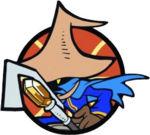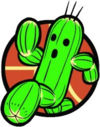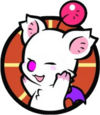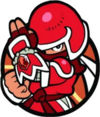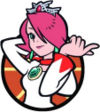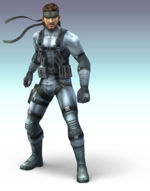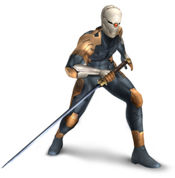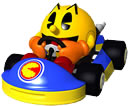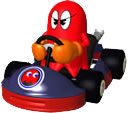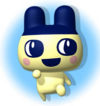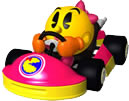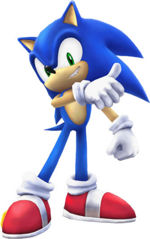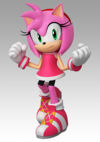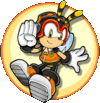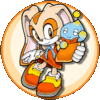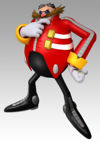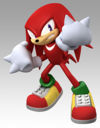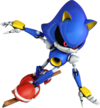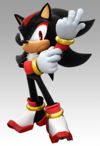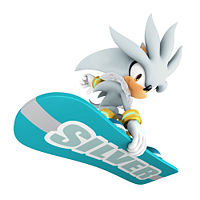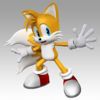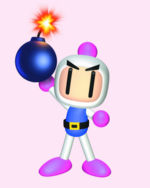Difference between revisions of "Third Party Characters in Nintendo Games"
| Line 379: | Line 379: | ||
Pac-Man has an extensive circle of friends and family. This includes his wife, Ms. Pac-Man; his children Baby Pac and Pac-Jr.; the trusty Professor Pac; and his dog, Chomp Chomp. They live in Pac-Land. Aside from the ghosts in the original games, Pac-Man's other enemies include the Ghost Witch, an evil Pac-Man impersonator called Toc-Toc, an ancient ghost monster named Spooky and a mad genius called Erwin. Additionally, his age is the same as the age of the game series (for example, he celebrates his twentieth birthday in ''Pac-Man World'', which was released in 1999, twenty years after the release of the original game). | Pac-Man has an extensive circle of friends and family. This includes his wife, Ms. Pac-Man; his children Baby Pac and Pac-Jr.; the trusty Professor Pac; and his dog, Chomp Chomp. They live in Pac-Land. Aside from the ghosts in the original games, Pac-Man's other enemies include the Ghost Witch, an evil Pac-Man impersonator called Toc-Toc, an ancient ghost monster named Spooky and a mad genius called Erwin. Additionally, his age is the same as the age of the game series (for example, he celebrates his twentieth birthday in ''Pac-Man World'', which was released in 1999, twenty years after the release of the original game). | ||
| − | Pac-Man is playable in both ''Mario Kart Arcade GP'' and ''Mario Kart Arcade GP 2'' as a heavyweight character. His special items in the first game, the same as Ms. Pac-Man's, are the Power Pill, Pooka, Rally-X and Galaga Boss. In ''Super Smash Bros. for Nintendo 3DS/Wii U'' and ''Super Smash Bros. Ultimate'', Pac-Man appears as a playable fighter. A variety of his moves are loosely based on his actions in the ''Pac-Man'' games, but he also has moves referencing other Namco games (such as one which can summon Galaxian Starships) and can throw the ghosts from his game as his Smash attacks. His Final Smash, known as Super Pac-Man, has him transforming into a giant 2-D version of his 8-bit self and chomping at the players onscreen, similar to when he attacks the ghosts in the original games. | + | Pac-Man is playable in both ''Mario Kart Arcade GP'' and ''Mario Kart Arcade GP 2'' as a heavyweight character. His special items in the first game, the same as Ms. Pac-Man's, are the Power Pill, Pooka, Rally-X and Galaga Boss. Pac-Man has also appeared as a possible [[Mystery Mushroom]] costume (based on his sprite from ''Pac-Land'') in ''[[Super Mario Maker]]'' that could be unlocked as a random prize for completing a 100 Mario Challenge on Expert or harder, or by scanning an amiibo of Pac-Man. A Pac-Man amiibo could also unlock a [[Yoshi]] pattern based on Pac-Man in ''[[Yoshi's Woolly World]]''. |
| + | |||
| + | In ''Super Smash Bros. for Nintendo 3DS/Wii U'' and ''Super Smash Bros. Ultimate'', Pac-Man appears as a playable fighter. A variety of his moves are loosely based on his actions in the ''Pac-Man'' games, but he also has moves referencing other Namco games (such as one which can summon Galaxian Starships) and can throw the ghosts from his game as his Smash attacks. His Final Smash, known as Super Pac-Man, has him transforming into a giant 2-D version of his 8-bit self and chomping at the players onscreen, similar to when he attacks the ghosts in the original games. | ||
Pac-Man was part of the default fighter in his original appearance, but in ''Ultimate'', he had to be unlocked through the game's variable-based system for unlocking characters or by awakening him in Adventure Mode (where he was found by on the western side of the chasm filled with giant mushrooms). His Classic Mode route in ''Ultimate'' was called "Ageless Classic" and followed the theme of pitting him against protagonists of the oldest games represented in the series in chronological order, with the route's boss being [[#Dracula|Dracula]] (due to him being the only boss character from a retro game). In the 3DS/Wii U game, Pac-Man's appearance was accompanied by two standard trophies in both games as well as a trophy for his Final Smash in the Wii U installment. In ''Ultimate'', he had his own Fighter Spirit. | Pac-Man was part of the default fighter in his original appearance, but in ''Ultimate'', he had to be unlocked through the game's variable-based system for unlocking characters or by awakening him in Adventure Mode (where he was found by on the western side of the chasm filled with giant mushrooms). His Classic Mode route in ''Ultimate'' was called "Ageless Classic" and followed the theme of pitting him against protagonists of the oldest games represented in the series in chronological order, with the route's boss being [[#Dracula|Dracula]] (due to him being the only boss character from a retro game). In the 3DS/Wii U game, Pac-Man's appearance was accompanied by two standard trophies in both games as well as a trophy for his Final Smash in the Wii U installment. In ''Ultimate'', he had his own Fighter Spirit. | ||
Revision as of 09:20, 5 January 2019
This article contains information on third-party characters who make guest appearances in official Nintendo games, either as playable characters or other major roles.
Bayonetta
Bayonetta
First Appearance: Bayonetta (2009)
Bayonetta, born under the name of Cereza, is the titular star of a pair of action games developed by PlatinumGames. She is one of the survivors of a group called the Umbra Witches and fights various enemies while investigating the truth of her past. She utilizes special gunfighting abilities known as Bullet Arts in battle.
Bayonetta was made available for purchase as a DLC fighter for Super Smash Bros. for Nintendo 3DS/Wii U in February 2016 (her and Corrin being the last DLC characters to be released) and reappeared as a normally unlockable fighter in Super Smash Bros. Ultimate (unlocked through the game's variable-based unlocking system or by unlocking her through Adventure Mode). Her design is based on her appearance in Bayonetta 2, although her original appearance is still present as an alternate costume, and her moves are based on abilities from her games. They involve a mix of hand-to-hand blows, firing invisible bullets and using magic such as the time-freezing Witch Time. Her smash attacks involve summoning one of Madama Butterfly's limbs to deliver attacks. Her Final Smash is Infernal Climax, in which she applies Witch Time to an extended field. She must then fill up the Climax Gauge in a limited time by attacking fighters in order to summon Gomorrah to attack them; a second gauge could also optionally be filled up to add more to the damage.
In the Adventure Mode of Ultimate, Bayonetta made an appearance during the opening cutscene, where she was among the fighters who came together to confront Galeem and his Master Hand army. Once Galeem unleashed his beams of light, Bayonetta attempted to escape by turning into a flock of bats, but she was ultimately forced to resume her normal form and was consumed by a beam of light. She later ended up under the control of Galeem's enemy, Dharkon, instead. She was not found until the area known as The Final Battle, where she would be among the last champions (and the last brainwashed fighter) left to fight on the side of darkness. After being defeated in battle, she would be awakened as her true self and join the roster of playable characters. In the game's Classic Mode, her route was called "The Requiem for Fallen Wings", and it followed a theme of pitting her against winged opponents. It was one of the few Classic Mode routes that did not feature any of the game's boss characters; instead, the route's last two fits were against a group of Pits and a giant Palutena, as a reference to the final battle of Bayonetta.
When she is downloaded into the 3DS/Wii U Smash, several trophies become available with her. These include two unlockable trophies available in both versions, a trophy of her appearance in the original Bayonetta and an unlockable trophy of her Final Smash in the Wii U game. There is also a trophy of her as a child, Cereza, as well as trophies of other characters from her series: Jeanne and Rodin. In Ultimate, there are two Fighter Spirits of Bayonetta, reflecting her two designs that are used for her costumes in the game, as well as a Novice-rank Support Spirit of Cereza (who would possess a tiny Bayonetta in Spirit battles).
Rodin
Castlevania
Castlevania is a series created by Konami that started with the original game that was released for the NES in 1986. The games are about the conflicts between different members of the vampire-slaying Belmont clan with vampires such as Dracula himself. The original game featured a side-scrolling platforming experience similar to that of Metroid, causing that particular type of platformer to be dubbed the "Metroidvania" style by fans. Castlevania originally crossed over with Nintendo through Simon Belmont and other characters appearing in Captain N: The Game Master, although they were vastly different from their portrayals in the games. Years later, Castlevania would be represented in Super Smash Bros. Ultimate, with Simon and Richter Belmont appearing as playable characters. This is the second Konami franchise (after Metal Gear) to be represented in the series and the only new third party franchise to be brought into Ultimate in a playable capacity.
Simon Belmont
First Appearance: Castlevania (1986)
Simon Belmont is a young vampire hunter who was featured as the protagonist of the first two Castlevania games. In those games, Simon clashed several times with the newly-revived Count Dracula in an attempt to prove himself as a member of the Belmont Clan, who were legendary vampire hunters. He was ravaged by a curse cast upon him by Dracula, but he eventually was able to successfully slay the vampire for good and was hailed as a hero. His main weapon was a whip known as the Vampire Killer, which was the legendary heirloom of the Belmont clan, and he also used several other weapons.
A version of Simon Belmont was also featured as one of the main characters of Captain N: The Game Master, a cartoon which mostly featured Nintendo characters. He had a different design and more of an arrogant personality, although he still took his duty to take down "The Count" seriously.
Simon would later appear as an unlockable playable character in Super Smash Bros. Ultimate. His moves utilize a mix of his Vampire Killer, his sub-weapons and martial arts moves. He also had an Echo Fighter in the form of Richter Belmont, his canonical descendant. In Ultimate, he could be unlocked through the game's variable-based system for unlocking characters or by awakening him in Adventure Mode (where he was found within the Temple of Light). His Classic Mode route, "Smash-vania", utilized opponents as homages to Castlevania enemies, ending with a battle against Richter and a boss fight against Dracula. Simon also had his own Fighter Spirit within the game that could be unlocked through his completion of Classic Mode or by purchasing it from the shop.
Richter Belmont
First Appearance: Castlevania: Rondo of Blood (1993)
Richter Belmont is another member of the Belmont Clan who wielded the Vampire Killer whip and was originally featured as the protagonist of Castlevania: Rondo of Blood. He went on a quest to save his fiancee Annette and others from Dracula. The people he saved included a young distance relative named Maria Renard, who insisted on helping him and became a secondary playable character. He later appeared as an antagonist in the game's sequel, Symphony of the Night, where he was possessed by the Dark Priest Shaft. He was ultimately saved, but he blamed himself for the incident and gave up the Vampire Killer to other descendants of the Belmont clan.
In Super Smash Bros. Ultimate, Richter was included as an unlockable playable character. He acts as an Echo Fighter of Simon and thus has a nearly identical moveset. The main difference between the two is that Richter's Holy Water unleashes blue flames instead of red and is considered to be an aura attack. In Ultimate, Richter could be unlocked through the game's variable-based system for unlocking characters or by awakening him in Adventure Mode. In Adventure Mode, he was found at the Dracula's Castle area, near Dracula's throne, but he only appeared after all of the area's ghosts had been destroyed. His Classic Mode route within the game was called "Smash Echoes" and followed the theme of fighting fellow Echo Fighters, ending with a boss fight against Dracula. His appearances was accompanied by a matching Fighter Spirit, which could be unlocked through his completion of Classic Mode or bought from the Vault's shop.
Alucard
First Appearance: Castlevania III: Dracula's Curse (1989)
Alucard is a character who was featured as a playable character in several Castlevania games, including being the main protagonist of Sympony of the Night. He is the son of Dracula and a human named Lisa, but he seeks to defeat his father and often works with members of the Belmont Clan to do so. His name is simply "Dracula" spelled backwards, but his true name is Adrian Fahrenheit Tepes.
He appeared in Captain N: The Game Master, but with a vastly different depiction; he was shown as a rebellious teenage vampire who rode around on a skateboard. In Super Smash Bros. Ultimate, Alucard appeared as an Assist Trophy. When summoned, he can use any of a number of attacks including sword attacks (wielding the Crissaegrim, a rare sword from Symphony of the Night as opposed to his standard Alucard Sword), physical attacks and turning into a bat to attack others who are further away. Alucard also made another cameo appearance during the Palutena's Guidance conversation about Richter. He appeared to tell Pit about Richter, but he also ended up talking about his own background in order to convince Pit that he was not a dangerous vampire. The conversation also coyly referred to his status as an Assist Trophy, as Palutena asked Alucard if he intended to take part in the battles, and his response was that he was merely her to "assist" Richter and anyone else who called upon him.
Alucard also appears as a Legend-rank Primary Spirit with the added effect of raising the strength of sword attacks. When fought against in Spirit battles, Alucard's Spirit would possess Simon Belmont in a battle where he receives aid from his Assist Trophy self.
Dracula
First Appearance: Castlevania (1986)
Count Dracula Vlad Tepes is an evil vampire who acts as the main antagonist of most of the games of the Castlevania series. He is based on the public domain character of Dracula from Bram Stroker's 1897 novel who in turn was based on the historical figure known as Vlad the Impaler. He is a vampire who terrorizes humanity and constantly clashes with members of the Belmont Clan. He has died many times, but he has also often been revived. One game revealed that he originated as a human Crusader named Mathias Cronqvist, who was friends with Leon Belmont. However, he was scarred by the sudden death of his wife Elisabeta and declared war on god. This led him to claim an artifact called the Crimson Stone and used it to become a vampire, at which point he changed his name to Dracula Vlad Tepes. A version of Dracula made several appearances in Captain N: The Game Master, where he was referred to only as The Count.
In Super Smash Bros. Ultimate, Dracula appeared as one of the game's boss characters, and his shadow could sometimes be seen in the Dracula's Castle stage. As a boss, he was fought in two forms. In his first form, he was a human-like vampire who teleported around while unleashing magical attacks. His body could be walked through, and he was only vulnerable to attacks to the head. After being beaten in this form, he would transform into his second monstrous form (from Rondo of Blood), which unleashed a series of physical and magical attacks. In Classic Mode, he appeared as the final boss of Simon, Richter, Luigi and Pac-Man's routes. In Adventure Mode, he was one of the three bosses who had to be defeated within The Dark Realm, and he was faced at the end of an area based on Dracula's Castle.
Dracula also has two Ace-rank Spirits that are gained by defeating him in Adventure Mode. The first is a Primary Spirit of his first form, which could be enhanced into a Legend-rank Spirit of Soma Cruz when brought up to Level 99. The second was a Support Spirit of Dracula's second form, which enabled unflinching charged smashes for players.
Other
The following are characters who make occasional background appearances in the Dracula's Castle stage and are also present in Ultimate as Spirits:
- Carmilla
- The Creature and Flea Man
- Death
- Kid Dracula (seen in shadow only)
- Medusa Head
- Mummy
- Werewolf
The following are characters who appear solely in Spirit form in Ultimate:
- Charlotte Aulin
- Gabriel Belmont
- Hector
- Hugh Baldwin
- Jonathan Morris
- Julius Belmont
- Juste Belmont
- Leon Belmont
- Maria Renard (enhances to her older self from Symphony of the Night)
- Nathan Graves
- Reinhardt Schneider
- Shaft
- Shanoa
- Soma Cruz (enhanced from Dracula)
- Trevor C. Belmont
- Yoko Belnades
Final Fantasy/Dragon Quest
The following are characters from Square-Enix's Final Fantasy series who appear as unlockable characters in Mario Hoops 3-on-3 and Mario Sports Mix. Mario Sports Mix adds a playable character from the Dragon Quest series, which had been developed by the "Enix" half of Square-Enix. None of these are actually specific characters, but rather are generic members of recurring classes or creatures in the series.
Additionally, Final Fantasy characters with Super Smash Bros. representation shall be listed here. Cloud Strife first appeared as a DLC fighter in Super Smash Bros. for Nintendo 3DS/Wii U and was later included in Super Smash Bros. Ultimate.
Behemoth
First Appearance: Final Fantasy II (1988)
The Behemoth is a ferocious beast that has appeared as a recurring enemy throughout the Final Fantasy series. It appears as the final boss of Mario Sports Mix's normal mode, where the team must use their skills from the sports games to fight off the Behemoth. It can attack with its claws and tails, by charging forward, performing a body slam, and by firing fireballs, lightning and meteors. Defeating it unlocks the Sports Mix Mode, where the more powerful Behemoth King is the final boss.
Behemoth King
First Appearances: Final Fantasy (1987)
The Behemoth King is a stronger version of the Behemoth from the Final Fantasy series that is red instead of blue. In Mario Sports Mix, it is featured as the final boss of Sports Mix Mode. It is more resilient and more powerful than the normal Behemoth but is otherwise similar.
Black Mage
First Appearance: Final Fantasy (1987)
The Black Mage has been around since the first Final Fantasy. They are usually armed with staffs, but their true power lies in their magic. Black Mages are usually seen wearing a blue robe with a tall yellow hat. Their faces are usually hidden.
In Mario Hoops (as well as Sports Mix), Black Mage is classified as a tricky player and is nicknamed Abracadabra Kid. His special shot, Meteor Shot, is based on the spell Meteor.
Bomb
- This article is a stub. You can help the Gamehiker Wiki by expanding it.
Cactuar
First Appearance: Final Fantasy VI (1994)
Cactuar is monster in the Final Fantasy series. He resembles a cactus with arms and legs. The Cactuar are very fast, very hard to hit, and have high defense. Their signature attack is 1000 Needles, which deals 1000 HP of damage.
In Mario Hoops, Cactuar is classified as a speedy player and is nicknamed Stick & Sting. His special shot in the 1000 Needles Shot. Additionally, Chocobos appear around Cactuar's head after it has performed its special shot. In Sports Mix, Cactuar is reclassified as a tricky player.
Cloud Strife
First Appearance: Final Fantasy VII (1997)
Cloud Strife is the protagonist of Final Fantasy VII. He is an amnesiac hero who had been experimented on and works with others to fight against the corrupt organization Shinra and Sephiroth.
In Super Smash Bros. for Nintendo 3DS/Wii U, Cloud can be purchased for download as a playable character. His presence in the game comes with two trophies and a trophy for his Final Smash. He returns in Super Smash Bros. Ultimate as an unlockable playable character. He has two sets of alternate costumes, using his original appearance and from his appearance from Advent Children. He has a number of attacks with his sword, as well as special attacks based on his moves from canon, with his Final Smash being the Omnislash. He also has a Limit Gauge that can be charged to enhance the power of his special attacks.
In Ultimate, he can be unlocked either through the game's variable-based unlocking system or by awakening him in Adventure Mode. Within Adventure Mode, Cloud was found in the Sacred Land and was guarding the pedestal of the Master Sword. He had to be defeated there to awaken him and unlock him for that mode. His Classic Mode route in the game was called "A Ride? Not Interested." Based on the character's motion sickness, all of the route's battles are set on moving stages. Within the game, two Fighter Spirits could be unlocked for Cloud, one for his default appearance and the other for his Advent Children costume. Uniquely, he is the only Final Fantasy representation within Ultimate, even counting Spirits.
Malboro
- This article is a stub. You can help the Gamehiker Wiki by expanding it.
Moogle
First Appearance: Final Fantasy III (1990)
Moogles are a race in the Final Fantasy series. They resemble white cats with wings and a red "pom-pom" coming out of their head. They are usually helpful and sometimes even join the game's hero on his quest.
In Mario Hoops (as well as Sports Mix), Moogle is classified as a tricky player and is nicknamed Game & Watch Me. His special shot is the Moogle Dance, based on a Limit Break from Final Fantasy VII.
Ninja
First Appearance: Final Fantasy (1987)
Ninjas have been around since the first Final Fantasy. They prefer lightweight armor and make sure to cover all parts of their body, including their face. Ninja swords, daggers, and boomerangs are the ninja's weapons of choice. They also have the ability to throw shuriken and scrolls for damage.
In Mario Hoops, Ninja is an all-around player and is nicknamed Mr. Invincible. His special shot is Leaf Veil. He has the same classification in Sports Mix, where his ability is to make copies of himself.
White Mage
First Appearance: Final Fantasy (1987)
White Mages were one of the first classes in the Final Fantasy series. Rather than damage opponents, white mages heal and protect their allies. They are normally dressed in white robes with red trim in a triangle pattern.
In Mario Hoops (as well as Sports Mix), White Mage is classified as a technical player and is nicknamed The Light. Her special shot, Holy Shot, is based on the spell Holy.
Slime
First Appearance: Dragon Quest (1986)
The Slime is a generic enemy that has appeared throughout the Dragon Quest series. It is known as the most common and basic enemy of the series, to the point where it is more or less the series mascot.
It appeared in Mario Sports Mix as one of the playable characters. It is classified as a tricky player.
Mega Man
Mega Man is a franchise that consists of several different series developed by Capcom. The "Classic" series started on the NES in 1987 with the original Mega Man games, and it spawned several different series starring other similar Mega Man characters. Mega Man makes a guest appearance in Super Smash Bros. for Nintendo 3DS/Wii U and Super Smash Bros. Ultimate as a playable character, and various other elements of the series have appeared within the games as well.
Mega Man
First Appearance: Mega Man (1987)
Mega Man is one of Capcom's mascot characters, and several different iterations of Mega Man have starred in their own series over the years. The original, 'normal' Mega Man is an invention of Dr. Light's. Originally created as a lab assistant named Rock, he volunteered to be converted into a fighting robot to stop the evil Dr. Wily, who had turned some of Dr. Light's robots into his servants. He has since ended up foiling many of Wily's schemes over the years. Mega Man is armed with an arm cannon known as the Mega Buster, and he also absorbs the main ability of every Robot Master he defeats.
In the Super Smash Bros. series, Mega Man is included as a playable character in Super Smash Bros. for Nintendo 3DS/Wii U and in Super Smash Bros. Ultimate. His abilities are very similar to those in canon. One of his moves summons his robotic dog Rush to act as a spring (or in the 3DS version it could be replaced with a custom move using the robotic bird Beat instead), and he also uses some different Robot Master abilities from various Mega Man games. His Final Smash, Mega Man Legends, calls together various other incarnations of Mega Man (as well as allies Proto Man and Bass in Ultimate) to deliver a super-sized Mega Blast. The other Mega Men who appear for that Final Smash are X (from the Mega Man X series), MegaMan Volnutt (from the Mega Man Legends series), MegaMan.Exe (from the Mega Man Battle Network series) and the incarnation of Mega Man from Mega Man Star Force.
He was a starting fighter in his first appearance, but in Ultimate, he had to be unlocked, either by awakening him in Adventure Mode, or by unlocking him through the game's variable-based system for unlocking characters. In Adventure Mode, Mega Man could be found at the Base Area. In Classic Mode, Mega Man's Classic Mode route was called "Variable Weapons Systyem: Online!". It was themed around having opponents stand in for the Robot Masters from the Mega Man series. The boss fight was against Galleom and was the second-to-last battle of his route. The final battle was against Dr. Mario followed by Mewtwo, emulating Dr. Wily and the Alien from Mega Man 2.
His appearance in the 3DS/Wii U Smash is accompanied by two unlockable trophies in each version of the game, as well as trophies for Rush, Beat, and each of the different incarnations of Mega Man that were present in his Final Smash. The Wii U version also has an unlockable trophy for Mega Man's Final Smash. Additionally, there are downloadable outfits for Mii Gunners based on X and Megaman.Exe. In Ultimate, Mega Man can gain his own Fighter Spirit from completing Classic Mode. There are also Primary Spirits for all of the forms of Mega Man from his Final Smash: X (who can be enhanced into a Spirit of Full Armor X), Volnutt, MegaMan.EXE and the Star Force Mega Man (as well as one for the beings who form him: Geo Stelar and Omega-Xis). There are also Spirits of Rush and Beat, as well as of Model X and Model ZX from the Mega Man ZX series.
Dr. Wily
First Appearance: Mega Man (1987)
Dr. Wily is the main antagonist of the Classic Mega Man series. He is a former colleague of Mega Man's inventor, Dr. Light, but he seeks to conquer the world. To do so, he often invents Robot Masters or corrupts existing ones to do his bidding. He also acts as the final boss of each Mega Man game, piloting some time of deadly machine. He has also been implied to be the creator of Zero and the Maverick Virus in the Mega Man X series.
He initially appears just as a trophy in Super Smash Bros. for Nintendo 3DS/Wii U. He later appears as an Assist Trophy in Super Smash Bros. Ultimate, where he pilots his Wily Capsule and attacks with different elemental blasts. It is possible to destroy his capsule, which will cause Wily to fall to the ground and beg for mercy, as he does when defeated in several Mega Man games.
In Ultimate, he also appears as two different Spirits. One is a Legend-rank Support Spirit (with the effect of slowing the rate at which an enemy's Final Smash meter charges), and the other is an Ace-Rank Primary Spirit of the Wily Capsule. When fought in a Spirit battle for the former Spirit, Dr. Wily would possess Dr. Mario in a stamina battle where the player has to defeat eight metal Mega Mans (in reference to the eight Robot Masters) before fighting the doctor himself. In Spirit battles for the latter Spirit, Wily's Spirit would instead possess a giant metal ROB in a stamina battle where he is aided by his Assist Trophy self. In addition, Dr. Mario also stood in for Dr. Wily as part of the final battle of Mega Man's Classic Mode route.
Elec Man
First Appearance: Mega Man (1987)
Elec Man was one of the bosses of the original Mega Man game. He was part of a set of six Robot Masters (or eight in the remake version known as Mega Man Powered Up) that Dr. Light originally created to do good in the world. However, Dr. Wily reprogrammed them for evil. He was known for being one of the harder enemies, but he was ultimately destroyed by Mega Man. He was weak against the Rolling Cutter, Cut Man's weapon (or Oil Man's weapon, the Oil Slider, in Powered Up) and gave up the Thunder Beam weapon.
He appears in Super Smash Bros. for Nintendo 3DS/Wii U and Ultimate as an Assist Trophy. When summoned, he will run and jump around the area while discharging electricity in one of three directions. His appearance is accompanied by a normal trophy in the 3DS/Wii U game and by an Advanced-rank Primary Spirit in Ultimate. His Spirit came with the effect of boosting electric attacks. When fought in a Spirit battle, Elec Man's Spirit would possess Pikachu (in the Pikachu Libre costume) in a stamina battle held over an electrified floor and with his electric attacks being strengthened.
Mettaur
First Appearance: Mega Man (1987)
The Mettaur (often called 'Met' for short and previously localized as 'Metool' and 'Metall') is a generic robot enemy appearing throughout the Mega Man series. It resembles a small head with feet attached and wears a hard hat that makes it impervious to most attacks. They have to be attacked when they are not hiding under their hard hat, although a few weapons throughout the series can bypass the hard hat's defense.
In Super Smash Bros. for Nintendo 3DS, the Mettaurs are among the enemies that appear in Smash Run. There is also trophy available for it in both the Wii U and 3DS versions. In Ultimate, the Mettaur appears as a Novice-rank Primary Spirit which lowers jumping ability. When fought in a Spirit battle, the Mettaur's Spirit would possess Pac-Man and fight in a stamina battle where it focused on shielding often and not jumping.
Yellow Devil
First Appearance: Mega Man (1987)
The Yellow Devil is a massive, one-eyed yellow robot. It is composed of a gooey material that allows it to disassemble in chunks, fly through the air and then reassemble. The Yellow Devil was originally featured in the original Mega Man as one of the bosses guarding Wily's Castle. Its only weakness was the Thunder Beam. Stronger versions of the Yellow Devil have appeared in later games.
In Super Smash Bros. for Nintendo 3DS/Wii U and Super Smash Bros. Ultimate, the Yellow Devil can appear as part of the Wily Castle stage. It occasionally forms by the edge of the stage and tries to attack players by firing laser blasts. It periodically disassembles and reassembles on the other side of the stage, with the chunks of its body causing damage to anyone hit by them. The Yellow Devil will eventually leave the area, but it is also possible to defeat it with attacks, at which point it will explode and injure any other characters caught in the explosion. In the Wii U game, the Yellow Devil must also be fought when encountered on the map in the Smash Tour mode. The Yellow Devil has also been represented by a trophy in the 3DS/Wii U game and an Ace-rank Primary Spirit (which reduces speed) in Ultimate.
Zero
First Appearance: Mega Man X (1993)
Zero is one of the supporting characters of the Mega Man X series, which was the second Mega Man series to be made, and he later starred in his own series, which was known as Mega Man Zero. He is a Maverick Hunter and former Maverick who works together with X to defeat various threats throughout the series, most of which relate to Sigma and the Maverick Virus. It was also revealed that he was originally created by Dr. Wily to kill Mega Man. After his initial adventures with X, he was frozen in a capsule and woke many years later, which started the Mega Man Zero series.
In Super Smash Bros. for Nintendo 3DS/Wii U, Zero only appears as a trophy and as a downloadable outfit for Mii Swordfighters. In Super Smash Bros. Ultimate, he appears as an Assist Trophy who attacks with his Z-Saber. He also has three Primary Spirits within the game, two of which are connected. His first Spirit is an Advanced-rank Spirit of him equipped with his Zero Buster. After leveling that Spirit up to Level 99, it can be enhanced into the second Primary Spirit, which is a Legend-rank Spirit of Zero with his Z-Saber, and it comes with boost to both weapon attack power and movement speed. There is also the third Spirit of Zero, a Ace-rank Spirit depicting Zero as seen in Mega Man Zero. During Spirit battles, the Spirit of Zero with the Z-Buster would possess a red Mega Man, while the Spirit of Mega Man Zero's Zero would possess Zero Suit Samus, and in both cases the Assist Trophy version of Zero would aid them in battle.
Other
In Super Smash Bros. for Wii U, the E-Tank/Energy Tank appears as an item in Smash Tour mode. It can be used at the beginning of a battle to automatically heal half a player's damage if they reach 100% damage. Its appearance is accompanied by a trophy in both the 3DS and Wii U games.
The following characters appear in the forms of both trophies in Super Smash Bros. for Wii U and Spirits in Ultimate:
- Bass (with Treble in trophy)
- Beat
- Dr. Light
- Eddie
- Proto Man
- Roll
The following characters appear only as Spirits in Ultimate:
- Air Man
- Axl
- Bomb Man
- Crash Man
- Cut Man
- Dark Man 4
- Dive Man
- Duo
- Drill Man
- Flame Man
- Flash Man
- Galaxy Man
- Gravity Man (Master Spirit in Adventure Mode, teaches Gravity Style at a dojo)
- Guts Man
- Hard Man
- Ice Man
- Knight Man
- Metal Man
- Napalm Man
- ProtoMan.EXE
- Roll Casket
- Shadow Man
- Sigma
- Skull Man
- Slash Man
- Spark Man
- Snake Man
- Sword Man
- Top Man
- Tron Bonne
- Quick Man
- Wind man
- Wood Man
Metal Gear Solid
The following characters are from Konami's Metal Gear Solid. Solid Snake has made guest appearances as a playable fighter in Super Smash Bros. Brawl and Super Smash Bros. Ultimate. Other characters from the series appear as either Assist Trophies, normal trophies, Spirits, stickers, or in Codec conversations.
Solid Snake
First Appearance: Metal Gear (1987)
Solid Snake is the hero of Konami's Metal Gear series. Though capable of deadly force, Snake usually uses stealth to achieve his mission. He has been trained in Close Quarters Combat, or CQC, as well as in using fire arms and explosives. Some of Snake's most memorable missions included stopping a military coup in Outer Heaven and preventing a nuclear crisis at the Shadow Moses facility in Alaska. He is also humorously known for hiding under a cardboard box, which is referenced in his Super Smash Bros. appearance.
Solid Snake appears as an unlockable playable character in Super Smash Bros. Brawl and Super Smash Bros. Ultimate. In Brawl, he was originally included at the request of his creator Hideo Kojima, and he was unlocked by playing 130 brawls, playing 15 brawls on Shadow Moses Island or by having him join the party in "The Subspace Emissary". In Ultimate, he could be unlocked through the game's variable-based system for unlocking characters, or by awakening him in Adventure Mode. Snake utilizes a variety of weapons in battle, and for his Final Smash he boards a helicopter and fires grenades at his opponents. Snake is also capable of making Codec calls on the Shadow Moses Island stage as a secret taunt, in which either Otacon, Mei Ling or The Colonel make contact with him and tell him about his opponents. Snake has three different trophies in Brawl: one normal one, one of his Final Smash, and one of his disguise of Pliskin. There are also two stickers of Snake which use artwork from Metal Gear Solid: The Twin Snakes and Metal Gear Solid 2: Sons of Liberty. In Ultimate, he has his own Fighter Spirit which is unlocked through his completion of Classic Mode, and there is also a Spirit for his Cardboard Box.
In the Adventure Mode of Brawl, "The Subspace Emissary", Snake was found aboard the Halberd, presumably doing some sort of reconnaissance work on the Subspace Army. When Meta Knight and Lucario infiltrated the Halberd, Snake initially hid from them in a cardboard box. However, Lucario was able to discover Snake by seeing his aura, and from his aura he could also see that they were on the same side. The three then teamed up to fight through the Subspace Army's forces on the ship, ultimately rescuing both princesses Peach and Zelda, whom Snake briefly flirted with afterwards. They ultimately discovered a squad of Mr. Game & Watch clones on the ship's deck, and dispatched them with apparent ease.
In the Adventure Mode of Ultimate, "World of Light", Snake appeared in the opening cutscene among the various fighters assembled to confront Galeem and his Master Hand army. When Galeem unleashed his beams of light, Snake simply tried to hide under his cardboard box, only to still be overtaken by one of the beams. Snake could ultimately be found within the Base area, and he was awakened and recruited by defeating him in a battle. Within the game's Classic Mode, Snake's personal route was called "Weapons and Equipment OSP". Its theme was based on opponents wielding projectile-based weaponry and/or explosives, with items based on weaponry and explosives being the primary ones to appear in the battles. The final battles of this route were against another Snake and then an boss battle with Galleom (likely intended as references to Liquid Snake and the Metal Gears, respectively).
Colonel Roy Campbell
First Appearance: Metal Gear 2: Solid Snake (1990)
The Colonel was the second in command of FOXHOUND and one of Snake's closest friends who appears as his commanding officer in Metal Gear 2 and Metal Gear Solid. He eventually retired from FOXHOUND, unhappy with the direction it was taking.
Within Super Smash Bros. Brawl, The Colonel is one of the three different officers who can communicate with Snake on the Shadow Moses Island level. A sticker of the Colonel also appears in the game. In Super Smash Bros. Ultimate, he appears as an Advanced-rank Support Spirit with the effect of preventing controls from being reversed. When fought against in a Spirit battle, Campbell's Spirit would possess Snake in a battle where he eventually receives a boost to both his attack and defense power.
Gray Fox
First Appearance: Metal Gear (1987)
Gray Fox, real name Frank Jaeger was a member of FOXHOUND, but went rogue with Big Boss. He was thought to have been killed by Solid Snake in Zanzibar Land, but reappeared at Shadow Moses Island. Grey Fox is a master swordsman and can turn completely invisible using his stealth camouflage.
Gray Fox appears as an Assist Trophy in Super Smash Bros. Brawl and Super Smash Bros. Ultimate. In the former game, his Assist Trophy is unlocked when Snake is unlocked as a playable character. He attacks by slicing at enemies with his sword, and his sword can also deflect projectiles. He has also been represented as a trophy and sticker (using artwork from Metal Gear Solid: The Twin Snakes) in Brawl and an Ace-rank Primary Spirit (using art from Metal Gear Solid: Revengeance) in Ultimate. When fought against in a Spirit battle, Gray Fox's Spirit would possess Sheik with enhanced move speed and would be aided in the battle by his Assist Trophy counterpart.
Mei Ling
First Appearance: Metal Gear Solid (1998)
The inventor of Snake's Codec, she also is the data analyst who saves the game in Metal Gear Solid. She was known for often relating Chinese proverbs. She had dreamed of becoming a jet pilot but could not due to poor eyesight. She later became a part of Philanthrophy and helped by stealing equipment. Otacon took her place as saving the game, but there was a special trick to make Mei Ling appear and chastise Otacon for messing up the proverbs.
Mei Ling appears within Super Smash Bros. Brawl as one of the characters who can communicate with Snake over the Codec about the other fighters. She considers Pikachu adorable and asks Snake to catch it for her. Mei Ling also appears as a sticker within the game. In Ultimate, she appeared as a Novice-Rank Support Spirit with the effect of raising energy shot resistance. When fought in a Spirit battle, her Spirit would possess a Wii Fit Trainer and fight alongside Snake.
Naked Snake
First Appearance: Metal Gear (1987)
Naked Snake was an early member of FOX in the 60's who assassinated The Boss and later became the Big Boss in charge of FOXHOUND. He founded the Les Enfantes Terribles project which created the three supersoldier clones Solid Snake, Liquid Snake and Solidus Snake. The Big Boss was the main enemy of the first two Metal Gear games but ultimately died in a duel with Snake. He is featured as the main character in several prequel games, most notably Metal Gear Solid 3.
Within Super Smash Bros. Brawl, Naked Snake appears as a costume variation for Solid Snake and has his own trophy. A sticker for the Big Boss also appears. In Super Smash Bros. Ultimate, Naked Snake appears as an Ace-rank Primary Spirit that can be enhanced at Level 99 into a Legendary-rank Spirit of Big Boss that comes with the Metal Killer effect. When fought in a Spirit battle, Naked Snake's Spirit would possess Solid Snake and fight alongside three copies of Snake, likely in reference to Les Enfantes Terribles.
Otacon
First Appearance: Metal Gear Solid (1998)
Otacon is the nickname of Dr. Hal Emmerich. He was a founding member of Philanthropy and a devoted anime fan who developed Metal Gear REX. He becomes a close ally of Snake after being saved by him in Metal Gear Solid and aids him over the Codec in Metal Gear Solid 2 as well as taking Mei Ling's place in saving the game but messing up the Chinese proverbs.
In Super Smash Bros. Brawl, Otacon communicates with Snake over the Codec in the Shadow Moses Island about certain characters. He is shown to be a fan of Captain Falcon. He also appears as a sticker within the same game. In Super Smash Bros. Ultimate, he appears under his real name as an Advanced-rank Support Spirit whose effect is to let a player fighter start a battle with a beam sword equipped. When fought in a Spirit battle, his Spirit would possess Dr. Mario and attempt to avoid the player in a stamina battle where a metallic ROB acted as his protector.
Other
The Metal Gear tanks Metal Gear RAY, Metal Gear REX and Gekko appear in the background of the Shadow Moses Island stage, and each has a trophy with the first two also having stickers in Brawl. All three of them also appear as Primary-rank Spirits in Ultimate, along with Metal Gear ZEKE (which can be enhanced into the Sahelanthropus at Level 99). Brawl also has trophies for the Shagohod tank (which also appears as a sticker) as well as Snake's Cypher item and the cardboard box. The cardboard box also has its own Support Spirit in Ultimate.
The following characters initially appear as stickers in Super Smash Bros. Brawl, and all of them except for Naomi Hunter reappear as Spirits in Ultimate.
- The Boss
- EVA
- Liquid Snake
- Master Miller/Kazuhira Miller
- Meryl Silverbough
- Naomi Hunter
- Raiden
- Revolver Ocelot (as a Spirit, starts as the Metal Gear Solid 3 version and can be enhanced into the Metal Gear Solid V version)
In Ultimate, other characters who appear as Spirits include Solidus Snake, Rosemary, Zero, Paz Ortega Andrade and Strangelove.
Pac-Man and other Namco properties
The following includes Namco-owned characters who appear as playable characters in Mario Kart Arcade GP and Mario Kart Arcade GP 2. Pac-Man, Ms. Pac-Man and Blinky are from Namco's popular Pac-Man series, while Mametchi (who only appears in Mario Kart Arcade GP 2 is from Bandai's Tamagotchi line of handheld pets (and is included due to a recent merger between Namco and Bandai).
Additionally, Pac-Man appears as a playable character in Super Smash Bros. for Nintendo 3DS/Wii U and Super Smash Bros. Ultimate, and thus several characters from the game as well as other Namco properties make cameo appearances and/or appear as trophies within these games.
Pac-Man
First Appearance: Pac-Man (1979)
Pac-Man is the spherical creature who is the protagonist of the Pac-Man series. In the original Pac-Man game, Pac-Man navigates a maze, eating everything in sight, while being chased by a group of ghosts. Pac-Man is defenseless against the ghosts unless he eats a special Power Pill, which will temporarily make the ghosts edible to Pac-Man and temporarily flipping the chase. Pac-Man later starred in more conventional console side-scrollers in the 1990's as well as 3-D platformers later on.
Pac-Man has an extensive circle of friends and family. This includes his wife, Ms. Pac-Man; his children Baby Pac and Pac-Jr.; the trusty Professor Pac; and his dog, Chomp Chomp. They live in Pac-Land. Aside from the ghosts in the original games, Pac-Man's other enemies include the Ghost Witch, an evil Pac-Man impersonator called Toc-Toc, an ancient ghost monster named Spooky and a mad genius called Erwin. Additionally, his age is the same as the age of the game series (for example, he celebrates his twentieth birthday in Pac-Man World, which was released in 1999, twenty years after the release of the original game).
Pac-Man is playable in both Mario Kart Arcade GP and Mario Kart Arcade GP 2 as a heavyweight character. His special items in the first game, the same as Ms. Pac-Man's, are the Power Pill, Pooka, Rally-X and Galaga Boss. Pac-Man has also appeared as a possible Mystery Mushroom costume (based on his sprite from Pac-Land) in Super Mario Maker that could be unlocked as a random prize for completing a 100 Mario Challenge on Expert or harder, or by scanning an amiibo of Pac-Man. A Pac-Man amiibo could also unlock a Yoshi pattern based on Pac-Man in Yoshi's Woolly World.
In Super Smash Bros. for Nintendo 3DS/Wii U and Super Smash Bros. Ultimate, Pac-Man appears as a playable fighter. A variety of his moves are loosely based on his actions in the Pac-Man games, but he also has moves referencing other Namco games (such as one which can summon Galaxian Starships) and can throw the ghosts from his game as his Smash attacks. His Final Smash, known as Super Pac-Man, has him transforming into a giant 2-D version of his 8-bit self and chomping at the players onscreen, similar to when he attacks the ghosts in the original games.
Pac-Man was part of the default fighter in his original appearance, but in Ultimate, he had to be unlocked through the game's variable-based system for unlocking characters or by awakening him in Adventure Mode (where he was found by on the western side of the chasm filled with giant mushrooms). His Classic Mode route in Ultimate was called "Ageless Classic" and followed the theme of pitting him against protagonists of the oldest games represented in the series in chronological order, with the route's boss being Dracula (due to him being the only boss character from a retro game). In the 3DS/Wii U game, Pac-Man's appearance was accompanied by two standard trophies in both games as well as a trophy for his Final Smash in the Wii U installment. In Ultimate, he had his own Fighter Spirit.
Blinky/Ghosts
First Appearance: Pac-Man (1979)
Blinky is one of Pac-Man's recurring ghost enemies. Blinky is the red ghost and was first seen as one of the ghosts in the original Pac-Man. Blinky and the ghosts appear in numerous games causing trouble for Pac-Man and his friends. In Pac-Man World 3, however, Blinky and Inky were captured by the evil scientist Erwin, who wanted to drain all the energy from the ghosts' world. This led to Pac-Man teaming up with the remaining ghosts, Pinky and Clyde, to save them.
Blinky is playable in both Mario Kart Arcade GP and Mario Kart Arcade GP 2 as a lightweight character. His special items in the first game are the Petit Monster, Monster's Hammer, Flare Ball and Ghost Morph.
All four of the ghosts (Blinky, Inky, Pinky and Clyde) also appear in Super Smash Bros. for Nintendo 3DS/Wii U, in which Pac-Man can toss one of them in his Smash attacks. In the 3DS version, they also appear as hazards in the Pac-Maze stage, and in Ultimate, the ghosts can be summoned as an Assist Trophy.. Each of the ghosts has an individual trophy in both games along with a collective trophy for the four Ghosts. The 3DS version also has a "TURN-TO-BLUE" trophy which reflects the way they turn blue when targeted by Power Pellets. In Ultimate, there is an Advanced-rank Primary Spirit for the Ghosts and a Novice-rank Support Spirit for TURN-To-BLUE.
Fairy Queen
First Appearance: Pac-Land (1984)
The Fairy Queen (referred to as the Mother Fairy in the PAL version) is a character from the arcade game Pac-Land. In this game, Pac-Man finds a fairy under his hat and brings it back to the Fairy Queen in Fairyland. She gives him Magic Boots for completing his quest.
In Super Smash Bros. for Wii U, the Fairy Queen appears as part of the Pac-Land stage, in its Fairyland area, based on her appearance in the game. Her appearance is accompanied by a trophy.
Mametchi
First Appearance: Tamagotchi Generation 1 (1996)
Mametchi is one of the original virtual pets from the Tamagotchi series and is included in most of the Tamagotchi games. It is one of possible adult forms of a young Tamagotchi. With an IQ of 250, Mametchi is the smartest Tamagotchi as well as the healthiest. Its interests are books and computers. There are also various other Tamagotchi in the Mametchi family.
Memtchi is playable in Mario Kart Arcade GP 2, presumably as a lightweight character. Details about its appearance are unknown.
Ms. Pac-Man
First Appearance: Ms. Pac-Man (1981)
Ms. Pac-Man is the wife of Pac-Man. She first appears as the protagonist of Ms. Pac-Man in which she battles ghosts in a maze similar to Pac-Man in the original Pac-Man game. Afterwards, she became mostly a supporting character in the Pac-Man games. She also starred in the 2000 game Ms. Pac-Man Maze Madness in which she defeated the evil witch Mesmerelda with the aid of Professor Pac. She and Pac-Man have had two children, Pac-Jr. and Baby Pac.
Ms. Pac-Man is playable in both Mario Kart Arcade GP and Mario Kart Arcade GP 2 as a medium-weight character. Her special items are the Power Pill, Pooka, Rally X and Galaga Boss, which are the same special items used by her husband. She also makes a cameo appearance in the Pac-Land level of Super Smash Bros. for Wii U, but curiously has no other presence within either of the Smash games that Pac-Man appears in.
Other
The following are items and other miscellaneous trophies represented in Super Smash Bros. for Nintendo 3DS/Wii U.
- Power Pellet - The primary power-up from the Pac-Man games. When Pac-Man eats this, it temporarily turns the ghosts blue, and Pac-Man can eat them freely. In Smash, the Power Pellet can be used freely as Pac-Man's special move, and Power Pellets also appear in the Pac-Maze level of the 3DS game wherein other characters can turn the ghosts blue and make them disappear. The Power Pellet appears as a trophy in both versions.
- Bonus Fruit - Fruits that are collected for points in the original games. In Smash, Pac-Man's standard neutral move involves him cycling through different bonus fruit that he can throw, and each fruit has different properties. There is also a Galaxian, Bell and Key in the mix. In the Pac-Maze stage of the 3DS game, the individual fruits appear as they did in the original game and are collected for points. Both versions have a trophy for the Bonus Fruit.
- Fire Hydrant - Fire Hydrants originally appeared in Pac-Land as obstacles. In Smash, Pac-Man can use the fire hydrant to attack through his down special move. The fire hydrants are also present in the Pac-Land stage and it has its own trophy in both versions of Smash.
- PAC-MAZE (3DS) - The stage based on the original Pac-Man game, present in the 3DS Smash only. It is accompanied by a trophy in that versio.
- Pac-Man's House (Wii U) - Pac-Man's house from Pac-Land. It is shown in the Pac-Land stage in the Wii U version and has its own trophy within that version.
Other Namco properties with Smash presence:
- Special Flag - An item from the 1983 game Xevious. When used in Smash, the player can hold it up for three seconds and if they can remain immobile, it can end another KO to their score or increase their stock by one. Its appearance is accompanied by a trophy.
- Boss Galaga - A boss character from the Galaga series that appears in Smash as an item. When used, it hovers around the screen similar to in the original game and attempts to suck a player in with its tractor beam, but it can be destroyed. It is accompanied by a trophy.
- Bacura (3DS) - An enemy from Xevious. The Bacura is a set of invincible floating tiles that will reflect attacks. They appear as enemies in Smash Run and have their own trophy.
- Pooka (3DS) - The Pooka is a small red round creature that originally appeared as an enemy in the classic Namco game Dig-Dug and has also appeared as an enemy for Pac-Man in games such as the Pac-Man World games. In Smash, the Pooka appears as an enemy in Smash Run mode. They attack by attempting to surprise fighters by jumping out of the ground or walls, and when attacked they will inflate until they pop. Their appearance is accompanied by a trophy.
Sonic the Hedgehog
The following are characters from the SEGA's Sonic the Hedgehog series who appear as playable characters, or as non-playable referees in the crossover game Mario & Sonic at the Olympic Games as well as its follow-up-games: Mario & Sonic at the Olympic Winter Games, Mario & Sonic at the London 2012 Olympic Winter Games, Mario & Sonic at the Sochi 2014 Olympic Winter Games and Mario & Sonic at the Rio 2016 Olympic Games. Sonic is also featured as a playable fighter in Super Smash Bros. Brawl, Super Smash Bros. for Nintendo 3DS/Wii U and Super Smash Bros. Ultimate, so most of the following characters also appear in these games as trophies, stickers, Assist Trophies, Spirits and/or background cameos.
Sonic the Hedgehog
First Appearance: Sonic the Hedgehog (1991)
Sonic is the star of Sega's Sonic the Hedgehog action platforming series series. His main ability is his incredible running speed. He can run faster than Mach 1 and is able to use his speed to attack enemies. He has had many enemies over the years, but Dr. Eggman has been the main one. He spends most of his time traveling alone and lives by his own rules, as he sees saving the world as "a minor distraction". He actually is not interested in competitive racing unless it involves showing up Dr. Eggman (the most clear example of this being in the story of Sonic R, where Sonic is uninterested in the grand prix until he learns of Eggman's involvement in it, at which point he eagerly signs up).
During the 1990's, Nintendo and Sega were the head rivals in the video gaming industry, so their mascots Mario and Sonic were often treated as enemies by fans themselves. A dig at Sonic in a Nintendo game of the time appears in Cranky Kong's Video Game Heroes award ceremony at the end of Donkey Kong Country 2: Diddy's Kong Quest, when Sonic's shoes (along with Earthworm Jim's gun) are seen discarded by a trash can under a sign reading "No Hopers". However, things became friendlier after Sega dropped out of the console wars and became a third party developer for Nintendo. This eventually lead to Sonic and Mario appearing together in games, starting with Mario & Sonic at the Olympic Games.
In all games of the Mario & Sonic at the Olympic Games subseries, Sonic appears as one of the playable competitors. He's a speed-type competitor. This marks the first time that Sonic and Mario truly appear together, and in a capacity in which they are both playable.
Sonic has also become a regular character in the Super Smash Bros. series starting with his debut as an unlockable character in Super Smash Bros. Brawl. He was unlocked by either playing 300 brawls, beating Classic Mode with ten different characters, playing more than ten hours of brawls or by completing The Subspace Emissary. Sonic has two trophies, one being his standard trophy while the other is of Super Sonic. There are also two three different Sonic stickers (the first two from the different versions of the original Sonic the Hedgehog with the third being from the 2006 Sonic the Hedgehog) as well as one of Super Sonic from Sonic the Hedgehog 2. In "The Subspace Emissary", Sonic appears just towards the very end to cut through Tabuu's wing and prevent him from turning everyone into trophies again. He then joins in on the final battle.
Sonic returns as a playable character in Super Smash Bros. for Nintendo 3DS/Wii U and Super Smash Bros. Ultimate. In the former game, he was part of the game's initial roster and was the only third party character to carry over from Brawl, although Snake would later return in Ultimate. His appearance in the 3DS/Wii U installment is accompanied by two trophies in both games and a trophy of himself as Super Sonic in the Wii U game. In Ultimate, he had to be unlocked either through the game's variable-based unlocking system or by unlocking him in Adventure Mode. Sonic had a Fighter Spirit that was unlocked with his completion of Classic Mode, and there were also Spirits for Super Sonic and Sonic the Werehog.
Within the Adventure Mode of Ultimate, he made a prominent appearance during the opening cutscene. When Galeem unleashed his beams of light, Sonic was seen trying to outrun it, and he appeared to slow down in an attempt to save Pikachu, only to be hit by one of the beams of light. Sonic could later be found and awakened within the Sacred Land area. In Classic Mode, Sonic's personal route was called "At the Speed of Sound", and the theme of his opponents was that they each represented different characters or general games from the Sonic the Hedgehog series. It ended with a standard boss fight against Master Hand and Crazy Hand.
Sonic has also appeared in Super Mario Maker as a Mystery Mushroom costume (using his sprite from the original Sonic the Hedgehog) that could be unlocked as a random prize for clearing the 100 Mario Challenge on Expert or higher, or by scanning a Sonic amiibo. In Yoshi's Woolly World, a Yoshi pattern based on Sonic's appearance could be unlocked by scanning his amiibo.
Amy Rose
First Appearance: Sonic the Hedgehog CD (1993)
Amy Rose is a female hedgehog with a crush on Sonic. She first played the part of Sonic's damsel in distress, but as time has gone by she's become more independent. These days she can take care of herself and sometimes goes with Sonic on his adventures. Her weapon of choice is a large hammer.
In Mario & Sonic at the Olympic Games as well as all three of the Winter Games follow-ups, Amy is one of the competitors. She is an all-around character. She also appears as a trophy and sticker in Super Smash Bros. Brawl, a trophy in Super Smash Bros. for Nintendo 3DS/Wii U and an Ace Support Spirit in Ultimate. Her Spirit's Support effect is to raise the damage done to shields. When fought in a Spirit battle, Amy's Spirit would possess an Inkling, starting the battle with a hammer and with the ability to wield a hammer for longer, as well as increased move speed.
Blaze the Cat
First Appearance: Sonic Rush (2005)
Blaze is a princess who in her original appearance is said to be from an alternate dimension, but later games later show she is actually from the future where she works with Silver the Hedgehog. She protects the Sol Emeralds in a role similar to those of Sonic and Knuckles in protecting the Chaos Emeralds. She has the ability to control flames.
In Mario & Sonic at the Olympic Games and all three of the Winter Games follow-ups, Blaze is one of the competitors. She is an all-around character. She also appears as a trophy and sticker in Super Smash Bros. Brawl, a trophy in Super Smash Bros. for Nintendo 3DS/Wii U and an Advanced Support Spirit in Ultimate. Her Spirit's Support effect is for the player's fighter to start a battle with the Superspicy Curry effect in play. When fighting in Spirit battles, Blaze's Spirit possesses Robin in an area with the floor as lava. She starts the match wielding a Fire Flower, and her explosion and fire-related attacks are more powerful.
Chaotix
First Appearance: Knuckles' Chaotix (1995)
Team Chaotix are a group of three who were originally featured in the game Knuckles' Chaotix where they worked with Knuckles, and they have occasionally formed supporting roles in games since then. They have usually been shown as a detective agency. Vector the Crocodile is their strong leader who can harness the power of music, while Espio the Chamelon is a more stoic member with the ability of camouflage, and Charmy the Bee is a small and optimistic member of the group.
Within the Mario & Sonic games, Vector has been featured as a playable competitos from the beginning, being classified as a power-type competitor. Espio and Charmy have mostly been regulated to appearing as referees and in other NPC roles, although Espio was playable in the Long Jump events of Rio 2016.
In the Super Smash Bros. games, each member of the Chaotix has appeared as a sticker in Super Smash Bros. Brawl and as a trophy in Super Smash Bros. for 3DS. In Super Smash Bros. Ultimate, there was a Novice-rank Primary Spirit for the entire Chaotix. When fought in a Spirit battle, Vector would possess K. Rool, Espio would possess Sonic, and Charmy would possess Pikachu. All three of them would periodically turn invisible, in emulation of Espio's camouflage ability.
Cream
First Appearance: Sonic Advance 2 (2002)
Cream first met Sonic after being rescued from Dr. Eggman and then fought alongside him to rescue her mother, Vanilla. Cream is almost never seen without her Chao, Cheese. Cheese attacks enemies to defend Cream. Cream is also able to fly, with her ears acting as helicopter blades.
In most of the Mario & Sonic games, she acts as a referee and in other non-playable modes. She has only been playable in the 3DS version of Rio 2016 in the beach volleyball events. She also appears with Cheese in Super Smash Bros. Brawl as a trophy and sticker, in Super Smash Bros. for Nintendo 3DS/Wii U as a trophy and in Ultimate as an Advanced Support Spirit. Their Spirit's effect is to increase the player fighter's jump height. When fought against in a Spirit battle, Cream would possess Isabelle, while Cheese possessed a Squirtle, in a battle with lowered gravity.
Dr. Eggman
First Appearance: Sonic the Hedgehog (1991)
Dr. Eggman (real name Ivo Robotnik) is Sonic's primary adversary who wishes to control the world. In order to carry out his plans, Dr. Eggman needs to get his hands on the Chaos Emeralds. He uses his army of robots to do this, but he always seems to fail. He has usually sought the Chaos Emeralds to power various weapons, although recently he has used them to awaken powerful living weapons such as Chaos and Shadow in hopes of manipulating them for his own ends; such plans have usually backfired in his face.
In all of the Mario & Sonic games, Eggman has been featured as one of the playable competitors. He is a skill-type competitor. Eggman also has a descendant known as Eggman Nega, who makes non-playable appearances throughout the series before being playable in the Long Jump events of the 3DS version of Rio 2016.
Eggman also appears in Super Smash Bros. Brawl as a trophy and a sticker, in Super Smash Bros. for Nintendo 3DS/Wii U as a trophy and in Super Smash Bros. Ultimate as a Legend-Rank Primary Spirit who boosts the power of electric attacks. When fought in a Spirit battle, Eggman's Spirit would possess Morton Koopa Jr. and fight alongside a metallic Sonic in a battle with occasional bob-omb downpours.
Eggrobo
First Appearance: Sonic & Knuckles (1994)
The Eggrobo (also spelled Egg Robo within Smash) is a recurring enemy in the Sonic games. They are egg-shaped robots made to reflect Eggman's robots, which float in the air with jetpacks and are normally equipped with powerful blasters. These enemies primarily appeared in Sonic & Knuckles, were a number are unleashed upon Sonic in the Death Egg, and one runaway Eggrobo replaces Eggman as the boss whom Knuckles faces in his version of the storyline. They've only also appeared in Sonic Generations as enemies, and otherwise, aside from inspiring the E-100 characters, the Eggrobos have mostly appeared in sports spin-offs and other minigames.
In Super Smash Bros. for Nintendo 3DS, the Eggrobos appear as an enemy that can be faced in the Smash Run mode. Their appearance is accompanied by a trophy.
Flicky
First Appearance: Flicky (1984)
Flickies are small birds that live on Flicky Island in the Sonic series. They are often used by Dr. Eggman for "battery power" in his Badniks. Other small animals similar to Flickies are also used for this purpose.
In Mario & Sonic at the Olympic Games, Flickies make up part of the audience. In Super Smash Bros. for Wii U, they make an appearance in the Windy Hill Zone Stage along with the other animal friends from the early Sonic games: Pecky, Picky, Pocky, Cucky, Ricky and Rocky. That version also has an accompanying trophy for all of these animals, entitled the "Fauna of Windy Hill Zone".
Jet
First Appearance: Sonic Riders (2006)
Jet is a headstrong hawk who is the leader of the Babylon Rogues. He is a rival of Sonic's in the Extreme Gear races of the Sonic Riders games. He appears as a trophy and a sticker in Super Smash Bros. Brawl, a trophy in Super Smash Bros. for Nintendo 3DS/Wii U and an Advanced-rank Support Spirit (who boosted movement speed) in Super Smash Bros. Ultimate. Also, a playable model for Jet was found in the game data for Mario & Sonic at the Olympic Games, suggesting that he was originally intended to be playable in the game. He went on to make non-playable appearances in the following games, before being playable for the football events in Rio 2016.
Knuckles the Echidna
First Appearance: Sonic the Hedgehog 3 (1994)
Knuckles lives on Angel Island and is the last descendant of a lost civilization of echidnas. His duty is to guard the island, especially the Master Emerald, from intruders. He was originally tricked into fighting with Sonic, but later became a friendly rival. At times, he has teamed up with Team Chaotix.
In every game of the Mario & Sonic at the Olympic Games series, Knuckles has appeared as one of the playable competitors and is a Power-type competitor.
In Super Smash Bros. Brawl and Super Smash Bros. for Nintendo 3DS, he made occasional background appearances running through the loop in the background of the Green Hill Zone (sometimes accompanied by Tails and/or Silver the Hedgehog). A Mii Fighter costume of Knuckles was also made available starting in the 3DS/Wii U game (initially as DLC), and Knuckles later appeared in Super Smash Bros. Ultimate as an Assist Trophy who attacked opponents with a number of punching moves, including digging into the ground and attacking with an uppercut. He has also been represented by a trophy and sticker in Brawl, a trophy in the 3DS/Wii U game and an Ace-rank Primary Spirit (who boosts the power of fist attacks) in Ultimate.
Metal Sonic
First Appearance: Sonic the Hedgehog CD (1993)
As its name suggests, Metal Sonic is a robotic doppleganger of Sonic the Hedgehog created by Dr. Eggman. It is first employed in Sonic CD, complete with an infamous last stage where Sonic must race Metal Sonic. Metal Sonic has mostly appeared in spin-off games as well as reprising his role as a villain by upstaging Eggman to become the final boss of Sonic Heroes, having absorbed the DNA of various fighters to become a monstrous machine.
Metal Sonic appears in Mario & Sonic at the Olympic Winter Games as a playable character, and he has returned in every follow-up since then. A sticker of Metal Sonic from Sonic CD also appears in Super Smash Bros. Brawl, and in Super Smash Bros. for Nintendo 3DS he appears as a trophy. Metal Sonic also appears in Ultimate as an Advanced Primary Spirit with the added effect of raising the player character's speed. When fought in a Spirit battle, Metal Sonic's Spirit would possess a metallic version of Sonic in a timed stamina battle while equipped with a Rocket Belt.
Rouge the Bat
First Appearance: Sonic Adventure 2 (2001)
Rouge the Bat is a treasure hunter and jewel thief who has also worked as a government spy. She is very capable at stealth and combat. She has acted as an antagonist, ally and rival throughout her appearances in the games, and she is also known for her flirtatious dynamic with Knuckles the Echidna.
In the Mario & Sonic at the Olympic Games series, she initially made non-playable appearances as an opponent starting in Mario & Sonic at the Olympic Winter Games. She eventually became a fully playable character in Mario & Sonic at the Rio 2016 Olympic Games, but only for one sport (golf in the 3DS version and beach volleyball in the Wii U version). In the Super Smash Bros. series, she has been represented by a sticker in Brawl, a trophy in the 3DS game and a Support Spirit in Ultimate. As a Spirit, her Support effect is to boost the strength of aerial attacks. When fought in a Spirit battle, her Spirit possesses Fox McCloud. In the fight, some of her attacks are strengthened, and she heals herself by landing melee attacks on the opponent.
Shadow the Hedgehog
First Appearance: Sonic Adventure 2 (2001)
Shadow is one of Sonic's enemies turned rival. He was created by Eggman's grandfather, Gerald Robotnik fifty years ago with genetic material provided by the Black Doom. After the death of Gerald's granddaughter Maria, whom Shadow had a close bond with, Shadow became dedicated to destroying the world to gain revenge until he experienced an epiphany in Sonic Adventure 2 and helped Sonic to save Earth from the Biolizard. Shadow was supposedly killed afterwards, but Eggman was able to save him. After discovered his past, Shadow has become more of an ally to Sonic. Shadow has an ability called Chaos Control that lets him warp space and time in order to make him seem much faster then he is to the point where he appears to teleport around. He can also use the Chaos Emeralds to turn into a more powerful, golden form known as Super Shadow, much like Sonic.
In Mario & Sonic at the Olympic Games and all of its follow-ups, Shadow is one of the playable competitors. He is a speed-type competitor. He also appears in the Super Smash Bros. series as an Assist Trophy, starting in Super Smash Bros. Brawl where it is unlocked automatically with Sonic. When summoned, Shadow uses Chaos Control to slow down time. Shadow is also represented by a trophy and sticker in Brawl, a trophy in the 3DS/Wii U installment and two stages of a Primary Spirit in Ultimate. His first Spirit is an Ace-rank Spirit of his normal self, and after reaching Level 99, the Spirit can be enhanced into a Legend-rank Spirit of Super Shadow which comes with a boost to a player character's attack and speed while they are undamaged. When fought in a Spirit battle, Shadow's Spirit would possess Sonic and be aided in battle by the Assist Trophy version of Shadow.
Silver the Hedgehog
First Appearance: Sonic the Hedgehog (2006)
Silver the Hedgehog is a hedgehog who lives in the same future as Blaze the Cat, where they fight off Eggman Nega, who is a descendant of the original Eggman. He is unlike the other two hedgehogs in that he is slow and has psychic powers instead of the superspeed of the other hedgehogs. In Sonic the Hedgehog he had lived in an apocalyptic future that had been ravaged by the Iblis Trigger, so he went back in time to destroy it. At the end of the game the apocalyptic future seemed to have been overwritten, but Silver and Blaze still existed in the future.
In Super Smash Bros. Brawl, Silver can be sometimes be seen in the background of the Green Hill Zone running through the loop in the background (with or without Tails and Knuckles), and this cameo remains in later versions of the stage seen in the 3DS Smash Bros. and Ultimate. Silver is also represented through a trophy and sticker in Brawl, a trophy in the 3DS/Wii U game and an Advanced-rank Support Spirit (which increased the power of throwing and grabbing attacks) in Ultimate. When fought in a Spirit battle, Silver's Spirit would possess Sonic and start the battle equipped with the Black Hole item, which would also commonly appear during the battle.
Additionally, a playable model of Silver was found in the game data for Mario & Sonic at the Olympic Games, showing that he was intended to appear as a playable character at one point. Silver makes a fully playable appearance in Mario & Sonic at the Olympic Winter Game, and he returns in all of the follow-ups.
Tails
First Appearance: Sonic the Hedgehog 2 (8-bit) (1992)
Tails is a fox with two tails. He is Sonic's biggest fan and his closest companion. Thus he accompanies Sonic on most of his adventures. Tails is able to fly by spinning his tails and has a knack for mechanics.
In Mario & Sonic at the Olympic Games and its follow-up games, Tails is one of the playable competitors. He is a skill-type competitor. In Super Smash Bros. Brawl, he can be sometimes seen in the background of the Green Hill Zone level running through the loop (with or without Knuckles and Silver the Hedgehog), and this cameo is reprised in the following Smash Bros. games. There is also a Mii Gunner costume of Tails that was initially available as DLC in the 3DS/Wii U game and was later available within Ultimate. Tails has also been represented by a trophy and sticker in Brawl, a trophy in the 3DS/Wii U game and an Ace-Rank Support Spirit in Ultimate. His Spirit's Support effect is to increase the power of up special moves. When fought in a Spirit battle, Tails's Spirit would possess Fox McCloud in a low gravity fight with an appearance by Knuckles's Assist Trophy..
Other
Other playable characters from recent Mario & Sonic games include Sticks the Badger, an ally of Sonic's from the Sonic Boom version of continuity; as well as Zavok and Zazz, who are members of The Deadly Six, a group of antagonists from the game Sonic: Lost World. The Deadly Six were also represented by a trophy in the Wii U Super Smash Bros.
The following characters initially appear as stickers (with notes mentioning other Smash Bros. appearances) in Super Smash Bros. Brawl.
- Big the Cat (trophy in 3DS Smash; Spirit in Ultimate)
- Chao (Trophy in 3DS/Wii U Smash; Spirit in Ultimate, enhances to Hero Chao)
- Chaos (Spirit in Ultimate)
- E-102 Gamma (Spirit in Ultimate)
- E-103 Omega (Trophy in 3DS Smash; Spirit in Ultimate)
- Emerl
- Erazor Djinn
- Shahra
- Storm the Albatross
- Tikal
- Wave the Swallow
In Ultimate, there is also a Spirit of Infinite, a jackal mercenary who acted as one of the main antagonists of Sonic Forces.
Street Fighter
Street Fighter is a popular series of fighting games that has served as Capcom's flagship title. It started with the original Street Fighter, which was released as an arcade game in 1987. Street Fighter was first represented in the Super Smash Bros. series in Super Smash Bros. for Nintendo 3DS/Wii U as part of the game's DLC which included one playable character (the series' main character, Ryu). In Super Smash Bros. Ultimate, Ryu was part of the base game as an unlockable fighter, along with the additions of another playable fighter, an Assist Trophy and various Spirits.
Ryu
First Appearance: Street Fighter (1987)
Ryu is the main character of the Street Fighter series. He is a martial artist who participates in a variety of tournaments and clashes with the evil M. Bison. Some games have also explored Ryu struggling with his own dark side, known as Evil Ryu.
Ryu was first included as a DLC fighter for Super Smash Bros. for Nintendo 3DS/Wii U and was made available in June 2015. He was later included as an unlockable character in Super Smash Bros. Ultimate, where he could be unlocked through the game's variable-based system of unlocking or by awakening him within Adventure Mode (where he is found at the end of the Street Fighter-based World Tour area). His moves are based directly on his moves from the Street Fighter games, and using the control combos from the original game will make his attacks stronger. He has two Final Smashes, the Shin Shoryuken and the Shinku Hadoken, and which one he uses depends on whether or not an opponent is close to him.
His Classic Mode route in Ultimate is called "Seeking a Challenge". It emulates the gameplay of Street Fighter II in which all of the opponents are standing in for fighters from that game, and the battles are all stamina battles fought on the omega versions of stages. It ends with a battle against Master Hand (and Crazy Hand on higher difficulties) where Ryu is assisted by Ken.
In the 3DS/Wii U game, Ryu has two trophies in each version, and the Wii U version also includes a trophy for his Final Smash. In Ultimate, he has a Fighter Spirit.
Ken
First Appearance: Street Fighter (1987)
Ken Masters is a martial artist who acts as Ryu's best friend and rival. He lives in America, and over the course of the series, he has gotten married to a woman named Eliza and had a son named Mel as well as having taken on a student named Sean. Ken was originally conceived as a palette swap of Ryu for the second player to control in the first game, which has caused Sakurai to refer to Ken as having been one of the 'original' Echo Fighters.
In Super Smash Bros. for Nintendo 3DS/Wii U, a trophy of Ken came with the Street Fighter DLC pack. It was the only Street Fighter trophy for that installment that was not related to Ryu. Ken was later included in Super Smash Bros. Ultimate as an unlockable playable character who acted as an Echo Fighter of Ryu, with some variations from Ryu's moveset and gameplay. He also has his own pair of Final Smashes that, like Ryu's, depend on his range from the other fighter: Shinryuken and Shippu Jinraikyaku. He could be unlocked through the game's variable-based system for unlocking characters or by awakening him in Adventure Mode (where he was found at the Dracula's Castle area).
His Classic Mode route in Ultimate was called "Red-Hot Rivalry" and consisted of battles with rivals from other series, including the friendly rival Luigi. The boss of his route was Crazy Hand (with Master Hand on higher difficulties). Ken's appearance in this game was accompanied by an unlockable Fighter Spirit.
Guile
First Appearance: Street Fighter II: The World Warrior (1991)
Guile is a fighter who originally served as a major in the United States Air Force. In his appearances, he is motivated by a drive to avenge the death of his best friend, Charlie Nash, who was killed by Shadaloo. He also has a wife and daughter who hold him back from killing. It later turns out that he and Ken are brothers-in-law.
He was included as an Assist Trophy in Super Smash Bros. Ultimate. When summoned, Guile crouches in place and blocks most attacks that come his way, before attacking anyone who comes close with a Flash Kick. He will also released shots of his Sonic Boom attack. Guile is also present in the game as a Legend-rank Primary Spirit that comes with the bonus effect of enhancing the power of foot attacks. When fought in a Spirit battle, Guile's Spirit would possess Captain Falcon and fight alongside his Assist Trophy self in a stamina battle.
Other
The following characters only appear as Spirits:
- Akuma
- Balrog
- Blanka
- Cammy
- Chun-Li (a Street Fighter Alpha variant that enhances into Chun-Li as seen in Street Fighter II Turbo)
- Cody
- Dan
- Dee Jay
- Dhalsim
- E. Honda
- Fei Long
- Gen
- Ibuki
- Juri
- Karin
- M. Bison
- Nash
- Sagat
- T. Hawk
- Vega
- Yun & Yang
- Zangief (acts as a Master Spirit in Adventure Mode and teaches Overthrow Style at a dojo)
Other
Akira Yuki
First Appearance: Virtua Fighter (1993)
Akira Yuki is the main character of the Virtua Fighter series. He is a martial artist who was originally an assistant instructor at Yuki Budokan. He seeks to perfect his martial arts and so has entered the series' tournaments.
In the Super Smash Bros. series, Akira was first incorporated as a Mii Brawler costume in Super Smash Bros. for Nintendo 3DS/Wii U. In Super Smash Bros. Ultimate, Akira makes an appearance as an Assist Trophy and a Legend-rank Primary Spirit (with the side effect of raising fist attack power). When summoned as an Assist Trophy, he would attack opponents with punches and kicks. If fought against in a Spirit battle, Akira's Spirit would possess Ryu and fight alongside his Assist Trophy self in a stamina battle with high gravity where his physical and smash attacks have higher power. Akira's physical appearance in all of his Smash Bros. appearances is based on his original polygonal design.
Bomberman
First Appearance: Bomberman (1983)
Bomberman is the star of his own titular series, Bomberman, which is developd by Hudson. His games are typically puzzle-based that require Bomberman to use his bombs to get through. In the games, he is often differentiated as being "White Bomberman", since he is of a species composed entirely of near identical Madbombers. In some games, he works for an intergalactic police force. He is cheerful and well-meaning, but sometimes goofy. His rival is Black Bomberman (or Kurobon, Cool Black) who in most games, is usually the second player.
He appeared opposite of Wario in Wario Blast. The game is actually a Bomberman game in itself, but Hudson requested it include Wario to better sell the game in America. Because of this, Wario got top billing in what was originally a Bomberman game.
Bomberman also appears as an Assist Trophy in Super Smash Bros. Ultimate, where he plants bombs to attack opponents. He is also present as an Ace-Rank Primary Spirit. When fought against in a Spirit battle, Bomberman's Spirit would possess Toon Link and focus on bomb attacks.
Joker
First Appearance: Persona 5 (2016)
This character is the protagonist of Persona 5. His real name can be chosen by the player but is given as Ren Amamiya in other productions (except for the manga adaptation, where his name is Akira Kurusu). In the game, he is a transfer student at Shujin Academy who ends up leading a group known as the Phantom Thieves of Heart. They have the ability to enter the Metaverse, a space connected to people's hearts, and they use this ability to "steal" the hearts of their enemies and to make them confess to their crimes. In the Metaverse, Ren gains a disguise and goes by the codename of Joker. He has the ability to summon Personas.
Joker has been confirmed as a playable character for Super Smash Bros. Ultimate through DLC, to be made available as part of Challenge Pack 1.
Rathalos
First Appearance: Monster Hunter (2004)
Rathalos is a large and powerful type of flying wyvern that is featured as a recurring monster in the Monster Hunter series. They are highly territorial and hostile, and they attack with fire breath. There are also several other variations of Rathalos.
In the Super Smash Bros. series, Rathalos was first referenced in Super Smash Bros. for Nintendo 3DS/Wii U, where Rathalos Blademaster Armor (armor made from Rathalos materials) was available as a DLC costume for Mii Swordfighters. In Super Smash Bros. Ultimate, a Rathalos is featured as an Assist Trophy, a boss character and a Spirit. As both an Assist Trophy and a boss, it attacks with its fire breath, by flying around and with its claws.
Rathalos is featured as a boss in several characters' Classic Mode routes (specifically Yoshi, Marth and Duck Hunt) as well as within Adventure Mode. In Adventure Mode, it appears within the Forest Hill area within the Light Realm, where it flies around the map. Whenever the player nears it, Rathalos will fly away, until it settles on the western part of the map, where it can be battled. Defeating Rathalos in that mode would also unlock its Spirit, an Advanced-rank Support Spirit that boosts the power of air attacks.
| Playable Fighters in the Super Smash Bros. Series |
|---|
| Mario · Donkey Kong · Yoshi · Luigi · Link · Samus · Pikachu · Jigglypuff · Kirby · Fox · Ness · Captain Falcon Peach · Bowser · Dr. Mario · Zelda/Sheik · Young/Toon Link · Ganondorf · Pichu · Mewtwo · Falco · Marth · Roy · Ice Climbers · Mr. Game & Watch Wario · Diddy Kong · Pokémon Trainer <Charizard/Ivysaur/Squirtle> · Lucario · Meta Knight · King Dedede · Wolf · Ike · Pit · Lucas · Pikmin & Olimar · R.O.B. · Solid Snake · Sonic Rosalina & Luma · Bowser Jr. · Greninja · Villager · Lucina · Robin · Palutena · Dark Pit · Little Mac · Shulk · Wii Fit Trainer · Duck Hunt · Mii Fighters · Mega Man · Pac-Man Bayonetta · Cloud · Ryu · Corrin Daisy · K. Rool · Incineroar · Ridley · Dark Samus · Isabelle · Chrom · Inkling · Ken · Simon · Richter Piranha Plant · Joker · Hero · Banjo & Kazooie · Terry Bogard · Byleth · Min Min · Steve · Sephiroth · Pyra/Mythra · Kazuya Mishima · Sora |
